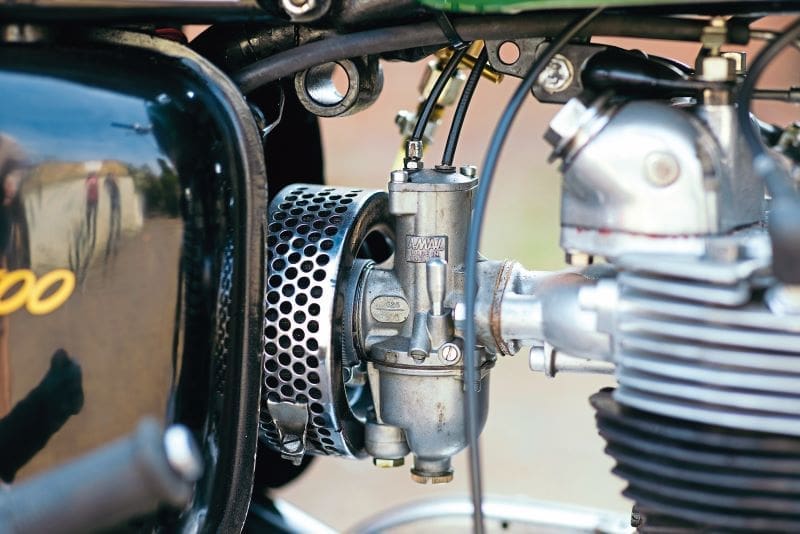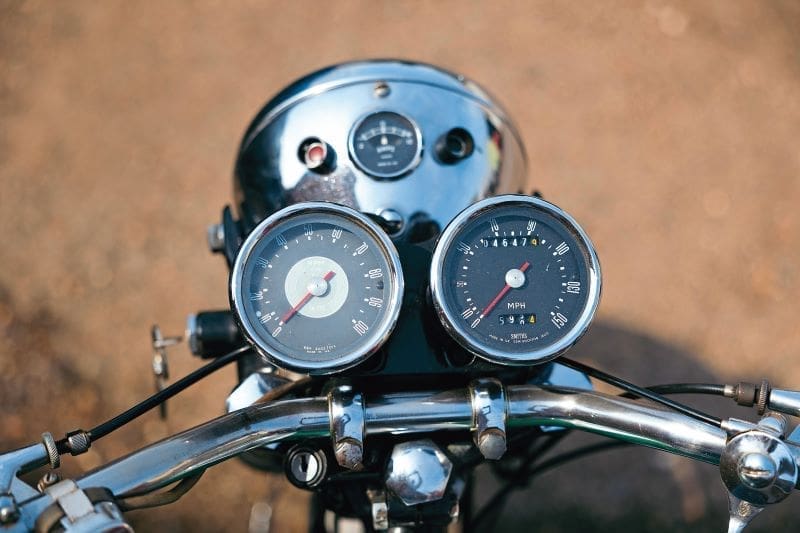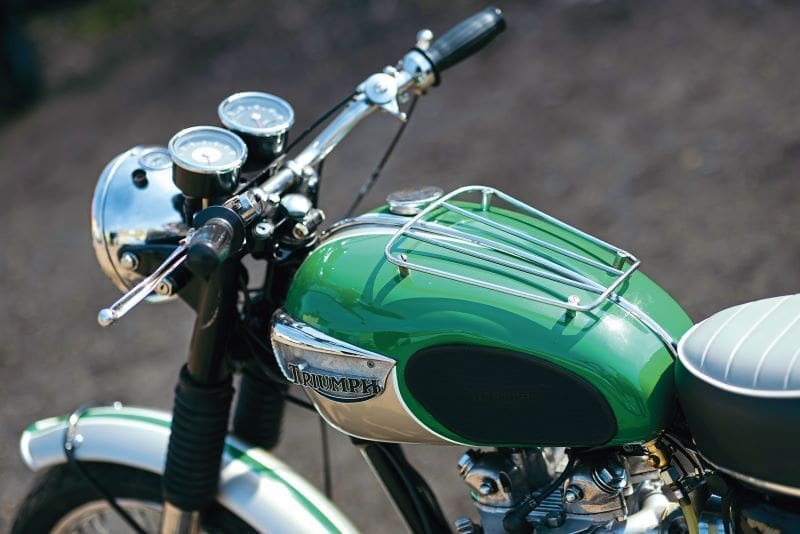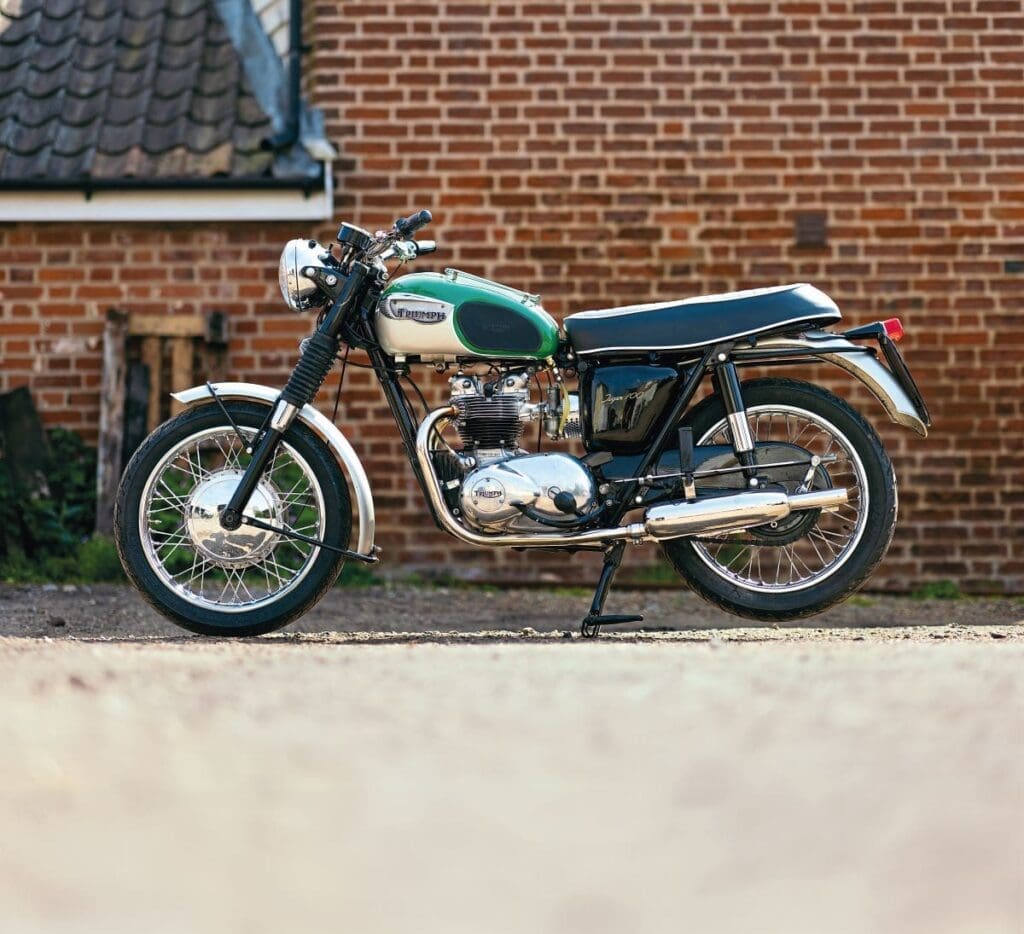There’s something about 500cc Triumphs which brings a smile to the face, exampled perfectly by this willing, beautifully presented version.

Words: James Robinson Photographs: Gary Chapman
The 500cc Triumph is the most important motorcycle the British motorcycle industry collectively made. Now, that’s some statement but bear with me…
You’ll notice I’ve kept some ambivalence to the declaration, in that it doesn’t say: ‘The Triumph 500cc twin is the most important motorcycle ever made.’ Which is because, although arguably that machine has a strong case, by saying ‘500cc Triumph’ in the original comment, it also opens it up to the early, pre-First World War models, which more than one motorcycle historian has pointed to being the machine which meant the motorcycle industry survived.
Enjoy more Classic MotorCycle reading in the monthly magazine.
Click here to subscribe & save.
Perhaps that sounds over the top, hyperbolic even, but the fact was, Pioneer-era motorcycles were beset by reliability problems, which led to a public distrust of them. After all, anything that had pedals surely wasn’t a signifier of great confidence by its makers. Although the Triumph did possess pedals, it did also have a reliability that others could only aspire too. And a bevy of men – headed by Albert Catt and Ivan Hart-Davies, but supported by plenty of others – proved that a Triumph, and by association ‘motorcycles’ in general, where capable of great feats of endurance, taking them way beyond the realms of that achievable with the pedal cycle, and thus proving the worth of the ‘motor’ cycle.
So sound was the Triumph design, others (BSA and Veloce come to mind immediately) took a good, hard look at it before producing its own machine, bearing a remarkable similarity to the product made in Priory Street, Coventry.
Direct descendants of those early Triumphs were to further enhance the image of capability and endurance with service during the First World War, admittedly headed by the 550cc (rather than 500cc) Model H, but that was clearly derived from the earlier, half-litre engine. And there were plenty of other noteworthy and important 500cc Triumphs too – what about the technologically advanced (engine wise) four-valve Ricardo for example, or the Model P, most noteworthy for its remarkable cheapness – in 1924, it cost £42-17s-6d while, to put it into context, a 350cc sidevalve AJS Model B was £62, a Norton Model 18, £89. Triumph duly sold 20,000 Model Ps in fairly short order.
There were a few other 500cc Triumphs of note, including the Victor Horsman-developed, two-valve ‘TT model,’ rugged sidevalves and stylish slopers, plus the sparkling 500cc 1936 Tiger 90, but the Big One was, of course, the 1937 Speed Twin, Edward Turner’s genius made into metal, the motorcycle being the very embodiment of its creator; everything about it bore the mark of ‘ET’ from its innovative modern lines, its skilfully (and bravely) chosen colour, its light weight, its sprightly performance. It was flash, brazen, modern, confident, maybe almost a bit too big for its boots and perhaps not quite as good as it thought it was… Just like the persona of Mr Edward Turner. A creation carries the mark of its creator.
That Speed Twin was only added to, with the next year launch of the Tiger 100, another example of real flamboyance (does anything say ‘1930s’ more than ‘cocktail shaker silencers’ – insomuch as the Tiger 100 had detachable baffles that came out in the manner of unscrewing the top of a cocktail shaker, thus resulting in the nickname) and demonstrating a reading and understanding of the desires of its potential audience. The first time I rode a pre-Second World War Tiger 100, I can distinctly remember thinking, ‘this was the first modern motorcycle.’ Of course, the Speed Twin felt much the same so should take that award, but that the the Speed Twin was on sale 10 years after my 1927 Longstroke Sunbeam (sidevalve, flat tank, hand gearchange, auxiliary oil pump and total loss oiling, lever throttle, no speedo nor lights, the list goes on) is, quite frankly, flabbergasting. So much progress, in so short a time.




Though the fact is, that from 1937-39, progress started to stagnate. Engine-wise, the prewar Tiger 100 feels pretty much the same as a 1940s, 1950s or 1960s one – like the one we have here, in fact. There’s that same frisky willingness so beloved of Triumph owners, a real feeling of lightness and being nimble. Though the last of the pre-unit 500cc models did get heavy, they were still lighter than other offerings, while the model as featured here, when compared to a contemporary BSA A50, for example, is like chalk and cheese. That’s not to say one is better than the other (having chalk to put in a sandwich is no use, while a lump of cheese is no good for writing on a blackboard) but they are different things, suited for different applications.
What’s the application for the unit 500cc Triumph twin then? Well, it’s, to me, the motorcycle personification (motorcycleification?) of ‘fun.’ To start with, it feels tiny, and that always helps, as it underlines that feeling of nimbleness. As soon as I get on one, I just feel like I’m going to have a good time, there’s almost a trailbike feel to the whole thing, owing to the overall size. Perhaps it just gives me subconscious flashbacks to my 1973 Suzuki TS125, my first motorcycle on the road, which basically equated to fun. Despite not really having anything in common whatsoever with each other, there’s something about the small size and nimbleness which stirs something in me. I immediately feel right at home.
Starting such a Triumph always seems easy too – there’s none of the ‘big single’ rigmarole either, just turn on the petrol and key and kick it, basically. It’s also a different type of kick, more a jab than the long, follow through on a one lunger, though, again, is that just my subconscious at work? Because the Triumph looks and feels small, it gets treated like that. But it also means it feels friendly and unthreatening, an eager to please motorcycle, the feeling of which is exacerbated when a blip of the throttle is rewarded with a willing rise in revs – even the exhaust note sounds eager.
That Triumph exhaust note reminds me of the aforementioned cocktail shaker silencers on the prewar Tiger 100 – and a ride after removing them from one. This basically created a pair of open megaphones, as were often fitted to the post-Second World Grand Prix, developed from the Tiger 100… ‘Loud’ is perhaps an understatement, while the noise emanating from our test subject was a much more friendly (or public friendly) cacophony; there’s a bit of bite there, but not the ‘rip your leg off’ suggestion, of a pair of open meggas. A blip of the throttle brings a fast-rising, pleasing increase in sound, an encouragement, or impatience, to get going. It will sit and happily idle, but it’d prefer to be under a bit of load.

The original Tiger 100 came out in 1939, a natural progression from the 250cc Tiger 70, 350cc Tiger 80 and 500cc Tiger 90 singles, all of which were launched in 1936 and all of which shared the same finish – including the silver mudguards, silver and chrome petrol tanks and blue lining. They did look ‘special’ in an era when colour was becoming in vogue, and though by the time the Tiger 100 came on the scene the political atmosphere was darkening horribly, the 1930s had, thus far, been the most colourful decade motorcycling had seen. It was to be the 1960s, really, before such brightness, in terms of finish, returned across the board, after the sombre nature of the 1940s and much of the 1950s was reflected in a return by the British industry to swathes of black-finished motorcycles.
Albeit, when the Tiger 100 returned to Triumph’s post Second World range, it was still in the same finish as prewar, though there were now telescopic forks up front. Interestingly, there was slated to be a ‘Tiger 85’ too, a hot version of the 3T, the new 350cc model, which was an altogether smaller motorcycle than the 500 version; there’s something interesting in this, as, later Tiger 100s like the one we’re riding here, came from the 350cc 3TA. What if the Tiger 85 had proved a real success and then Triumph’s early 1950s 500s had grown from the acorn, as the 500cc version became the 650cc models? That, though, didn’t happen, so while the Tiger 100 was the undoubted range topper for a few seasons, it was thoroughly overshadowed once the 650cc Thunderbird arrived on the scene for 1949, and when the Tiger 110 made its bow, the Tiger was pushed further down the pecking order, though it still had its advocates, of course. Other models were spawned from the Tiger 100 too; most notably, the Grand Prix as mentioned, which was basically a development of the alloy-barrelled Tiger 100 used by Ernie Lyons to win the 1946 Manx GP. It was introduced for public sale in 1948 where it continued until the 1950 season, albeit without any real top-level racing successes, though Don Crossley repeated Lyons’ MGP success in 1948 and notably Dave Whitworth enjoyed success on the continent on his GP, and the Trophy TR5 – its engine was also based upon the Speed Twin/Tiger 100, though initially using the same square alloy barrel, famously from a Second World War generator set, that was specified on the Grand Prix.
When the Clubman TT was introduced for 1947, it was no surprise that the Tiger 100 proved a popular mount for the Senior race, though best finisher was Eric Cheney (the man later famous for his frame building) in ninth. In the 250cc class, incidentally, Bill McVeigh won on his pre-Second World War Tiger 70, before he returned to come fourth – behind two 1000cc Vincents and a cammy Norton – in the 1948 Senior edition.

In the 1949 races, with the 1000cc machines in their own class (see page 72 of this issue for more on that) three of the top five were Tiger 100s, with Allan Jefferies the best in second, the same position Tiger 100s finished the next two years too, before finally a Tiger 100 enjoyed TT glory when Bernard Hargreaves raced his model to success in 1952. Though Derek Powell brought his T100 home fourth the next year, a position repeated by TA Owens in 1954 (a race in which Triumph employee Percy Tait was sixth… On a BSA Gold Star being barred from riding a Triumph in this amateur event) and Ian Atkinson was second in 1955 – the year journalist John Griffith wrote an account of his ride on a Tiger 100, to 13th place – in 1956, of the top 18, only John Hurlstone’s seventh-placed Triumph (a 1954 Tiger 100) was swimming in a sea of Gold Stars. The Clubman’s race was disbanded after that, though the Tiger 100 did have its single race win to underline its sporting credentials.
Meanwhile, the production Tiger 100 had the famous nacelle from 1949, while the sprung hub was offered too, then in 1950 the four-bar tank badge led to the end of the silver-and-chrome petrol tank, continued over from before the Second World War. The Tiger 100 also gained an alloy barrel. After the GP was discontinued, a race kit was offered for the T100 which offered twin carbs, high compression pistons, different cams and a bigger oil tank, ostensibly bringing the model up to GP specification. The model was listed in 1953 as the T100C, a proper sporting machine, while it was dropped by the time the Tiger 100 adopted the swinging arm frame, in 1955. By the end of the 1950s, the 650cc models were the ‘glamour’ offerings, especially once the Bonneville came in 1959, which was the last year of the Tiger which could trace its origins back to 1939.
For in 1960, the Tiger 100 became the Tiger 100A, the direct forerunner to our featured machine, albeit on launch it had bathtub rear enclosure and a two-tone black-and-cream finish, while it was developed from the 350cc Twenty-One. Soon, though, a naked (more ‘semi-naked’) Tiger 100 was back, which felt more in the spirit of its predecessors. Called the Tiger 100SS, it was to run through until 1965.




Dealer Andy Tiernan (www.andybuysbikes.com) had a late one advertised, alongside our featured machine, both having come from the same owner – however, I was too slow off the mark and the SS had already been sold and delivered by the time I asked for a go. Our subject machine also had a new owner, though he graciously allowed us to photograph and ride his machine.
Registered new in Lancashire on May 8, 1968, the engine number stamping beginning of ‘T100T’ shows that it would have originally worn twin carburettors and borne the name Daytona, in recognition of the Tiger 100 triumphs at 1966 and 1967’s Daytona 200 (which actually repeated a Tiger 100 win in 1962 when Don Burnett beat Dick Mann’s Matchless G50), while T100S continued with the single carb, as featured here. For 1968, the twin-carb 500s also had the twin-leading shoe front brake, as worn by the motorcycle featured. There were four versions of the Tiger 100 in 1968 – the T100T and US-market T100R with twin carbs, then the single carb T100S and US-only T100C, a single carb competition variant.
The story of the 1966 and 1967 Tiger 100 Daytona successes was one of clever development and planning, bringing to the line a machine which was conceived by Triumph top brass wholly to counteract the important development in that Honda was to bring a CB450 out – which Triumph needed to react to. By this time, Edward Turner (who saw no gain in racing) has been ousted from his almost dictatorial control and it was Doug Hele who oversaw, in just nine months, the development of what was a winning machine. Buddy Elmore took the 1966 success, but was beaten into second place the next year by like-mounted Gary Nixon. Though 1968 saw a host of annoying misfire failures, lessons learned this year, and the other years, as well as the works 500cc racer which spectacularly finished second at the 500cc Belgian GP, at Spa, Percy Tait up, in 1969, saw direct improvements made to the road going 500cc twin.

Elsewhere in racing, a Tiger 100 Triumph was third (David Nixon) in the newly-introduced 1967 Production TT, before Ray Knight won the 1968 class, and was runner-up the next year, a position Alan Rogers occupied on his T100 in the last, 1974, 500cc Production TT. While our 1968 feature machine is a fine one, supposedly the pinnacle of the 500cc Triumph was yet to come, with the later year machines (production ended in 1974) reckoned by some to be the best 500cc Triumph ever made.
And that brings us neatly back to where we started, in that, in all of its achievements and incarnations, overall, the 500cc Triumph is perhaps the top of pile. Whether that’s true or not, will be debated, but what can’t be denied is that an example like this one provides a cracking ride and lots of fun.
It’s the small size which is most endearing, feeling like a toy, while there’s also a puppyish eagerness to basically play. Turning, feet up, in the road, or riding up and down kerbs, all seems like a fun game, encouraged by the little Triumph’s friendly, joyful character. The twin leading show front brake worked great too, no surprise as it was also used to haul up the 650cc versions admirably, while the gearbox clicked into ratios (one down, three up) with a willingness that further underlined its capabilities.
Interestingly, Andy Tiernan told me that after he’d agreed to sell this machine (it was on offer at £5350, the same price as the earlier T100SS – both went, literally, in days) he was contacted and offered more than the asking price, in an attempt to gazump the new owner. It seems the Tiger 100 remains the sought-after motorcycle it has always been. And it’s no wonder why.

Advert
 Enjoy more The Classic MotorCycle reading in the monthly magazine. Click here to subscribe.
Enjoy more The Classic MotorCycle reading in the monthly magazine. Click here to subscribe.



